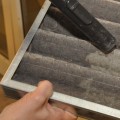Are you having trouble finding your HVAC filter? You're not alone. Many homeowners struggle to locate their air filter, especially if they have an older system. In this article, we'll provide a comprehensive guide to help you find your HVAC filter and learn how to change it. The air filter is usually located close to the boiler air controller or air conditioning system.
It's typically near the home thermostat, in a return duct, or right next to the air handler for your air conditioning system. Cascade air filter designs are the most common type of filters, and the wall filter is the first easily accessible stage of dust filtration. Generally, the air cleaner is placed on the return side, either on an intake grille or in a return air chamber. If you have a horizontal HVAC unit, the oven filter will be located on the inlet side and slide on a rack.
It's important to note that the edge of most air filters has an arrow showing the intended direction of air flow through the filter. Now that you know where to look for your HVAC filter, let's take a look at why it's important to know its location.
Why You Need to Know Where Your HVAC Filter Is Located
Knowing where your HVAC filter is located can help you find dirty or clogged filters that increase air conditioning or heating costs. Documenting the location of the HVAC system air filters can also help future building owners, occupants, or repairers.In some cases, homeowners may find that their HVAC unit doesn't have a filter installed. This can lead to dirt, debris, moisture and mold entering nearby basement areas. If this is the case for you, make sure to install a filter as soon as possible.
How Does an HVAC Filter Work?
HVAC filters work by trapping particles like dust and dirt before they enter your home's ventilation system.This helps keep your indoor air clean and free from allergens and other pollutants. When choosing an HVAC filter, it's important to consider factors like size, material and MERV rating. The size should match your system's specifications, while the material should be able to withstand high temperatures and humidity levels. The MERV rating indicates how effective the filter is at trapping particles. Once you've chosen an appropriate filter for your system, it's time to replace it.
Make sure to follow manufacturer instructions when replacing your HVAC filter.


